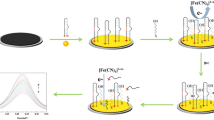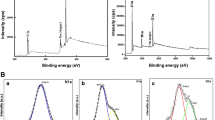Abstract
DNA sequences containing a polycytosine (Poly-C) can be strongly adsorbed on the surface of graphene oxide (GO) to enhance the physical adsorption between GO and DNA. Hg2+ can specifically bind to single-stranded DNA sequence with thiophosphate cleavage site (PS), and fluorescence is restored according to the principle of fluorescence resonance energy transfer (FRET). The LOD of Poly-C PS 1 site sensor was 1.11 nM. The LOD of Poly-C PS 2 sites sensor was 0.84 nM. In order to improve the detection signal of Hg2+, the ultra-thin silica shell (SiO2) was covered with metal nanomaterial Ag (Ag@SiO2), which improved the stability and the sensitivity of biosensors. The LOD of the two sensors decreased to 0.36 nM and 0.15 nM, respectively. This sensor was also used for Hg2+ detection in dendrobium.This shows that the method is promising.









Similar content being viewed by others
References
Bhardwaj V, Nurchi VM, Sahoo SK (2021) Mercury toxicity and detection using chromo-fluorogenic chemosensors. Pharmaceuticals 14(2):123
Bohari NA, Siddiquee S, Saallah S et al (2020) Optimization and analytical behavior of electrochemical sensors based on the modification of indium tin oxide (ITO) using PANI/MWCNTs/AuNPs for mercury detection. Sensors (basel) 20(22):6502
Chen ZY, Gupta A, Chattopadhyay S (2021) Detection of mercury in spiked cosmetics by surface enhanced Raman spectroscopy using silver shelled iron oxide nanoparticles. Sens Actuators, B Chem 337:129788
Chiapella AM, Eagles-Smith CA, Strecker AL (2021) From forests to fish: mercury in mountain lake food webs influenced by factors at multiple scales. Limnol Oceanogr 66(4):1021–1035
Dong J, Liu Y, Hu J et al (2017) A novel ferrocenyl-based multichannel probe for colorimetric detection of Cu(II) and reversible fluorescent “turn-on” recognition of Hg(II) in aqueous environment and living cells. Sens Actuators, B Chem 255:952–962
Fauzi NIM, Fen YW, Omar NAS et al (2020) Nanostructured chitosan/maghemite composites thin film for potential optical detection of mercury ion by surface plasmon resonance investigation. Polymers (basel) 12(7):1497
Gao L, Liu C, Li R et al (2019) Highly sensitive detection of Hg2+ using covalent linking single-strand DNA to the surface of graphene oxide with co-anchor strand. Anal Methods 11(35):4416–4420
Gao Y, Wang Z, Zhang X et al (2020) Observation and estimation of mercury exchange fluxes from soil under different crop cultivars and planting densities in North China Plain. Environ Pollut 259:113833
Ghosh S, Chatterjee K (2020) Poly (Ethylene Glycol) functionalized graphene oxide in tissue engineering: a review on recent advances. Int J Nanomedicine 15:5991–6006
Guerrero AR, Aroca RF (2011) Surface-enhanced fluorescence with shell-isolated nanoparticles (SHINEF). Angew Chem Int Ed 50(3):665–668
Hu Q, Han X, Dong G et al (2021) Association between mercury exposure and thyroid hormones levels: a meta-analysis. Environ Res 196:110928
Huang Z, Liu J (2018) Length-dependent diblock DNA with poly-cytosine (Poly-C) as high-affinity anchors on graphene oxide. Langmuir 34(3):1171–1177
Huang X, He Z, Guo D, Liu Y et al (2018) “Three-in-one” nanohybrids as synergistic nanoquenchers to enhance no-wash fluorescence biosensors for ratiometric detection of cancer biomarkers. Theranostics 8(13):3461–3473
Huang S, Cheng X, Lei Q et al (2020) Fluorescent sensors for detection of mercury: from small molecules to nanoprobes—ScienceDirect. Dyes Pigm 187:109125
Janse van Rensburg M, van Rooy MJ, Bester MJ et al (2020) Ultrastructural alterations of whole blood by copper, manganese and mercury metal mixtures using a chronic in vivo model of coagulation. Environ Toxicol Pharmacol 75:103314
Knoblauch R, Geddes CD (2019) Silvered conical-bottom 96-well plates: enhanced low volume detection and the metal-enhanced fluorescence volume/ratio effect. Nanoscale 11(10):4337–4344
Larsen TJ, Jørgensen ME, Larsen CVL et al (2018) Whole blood mercury and the risk of cardiovascular disease among the Greenlandic population. Environ Res 164:310–315
Lee J, Song J, Lee D et al (2019) Metal-enhanced fluorescence and excited state dynamics of carotenoids in thin polymer films. Sci Rep 9(1):3551
Li JF, Huang YF, Ding Y et al (2010) Shell-isolated nanoparticle-enhanced Raman spectroscopy. Nature 464(7287):392–395
Li Z, Sun H, Ma X, Su R et al (2020) Label-free fluorescence “turn-on” strategy for mercury (II) detection based on the T-Hg2+ -T configuration and the DNA-sensitized luminescence of terbium (III). Anal Chim Acta 1099:136–144
Liu L, Zhang R, Liu Y et al (2018) Insight into hydrogen bonds and characterization of interlayer spacing of hydrated graphene oxide. J Mol Model 24(6):137
Liu M, Zhang Q, Cheng M et al (2019) Rice life cycle-based global mercury biotransport and human methylmercury exposure. Nat Commun 10(1):5164
Lu C, Huang Z, Liu B et al (2017) Poly-cytosine DNA as a high-affinity ligand for inorganic nanomaterials. Angew Chem 56(22):6208–6212
Meleleo D, Notarachille G, Mangini V, Arnesano F (2019) Concentration-dependent effects of mercury and lead on Abeta42: possible implications for Alzheimer’s disease. Eur Biophys J 48(2):173–187
Montalti M, Zaccheroni N, Prodi L et al (2007) Enhanced sensitized NIR luminescence from gold nanoparticles via energy transfer from surface-bound fluorophores. J Am Chem Soc 129(9):2418–2419
Mukherjee SP, Gliga AR, Lazzaretto B et al (2018) Graphene oxide is degraded by neutrophils and the degradation products are non-genotoxic. Nanoscale 10(3):1180–1188
Nogara PA, Oliveira CS, Schmitz GL et al (2019) Methylmercury’s chemistry: from the environment to the mammalian brain. Biochim Biophys Acta Gen Subj 1863(12):129284
Nong Q, Dong H, Liu Y et al (2021) Characterization of the mercury-binding proteins in tuna and salmon sashimi: implications for health risk of mercury in food. Chemosphere 263:128110
Osorio-Román IO, Guerrero AR, Albella P et al (2014) Plasmon enhanced fluorescence with aggregated shell-isolated nanoparticles. Anal Chem 86(20):10246–10251
Panagos P, Jiskra M, Borrelli P et al (2021) Mercury in European topsoils: anthropogenic sources, stocks and fluxes. Environ Res 201:111556
Peng Z, Wu N (2017) Fluorescence and sensing applications of graphene oxide and graphene quantum dots: a review. Chem Asian J 12(18):2343–2353
Pyta H, Widziewicz-Rzońca K, Słaby K (2020) Inhalation exposure to gaseous and particulate bound mercury present in the ambient air over the polluted area of Southern Poland. Int J Environ Res Public Health 17(14):4999
Raju A, Singh A, Srivastava N et al (2019) Mapping human health risk by geostatistical method: a case study of mercury in drinking groundwater resource of the central ganga alluvial plain, northern India. Environ Monit Assess 191(Suppl 2):298
Ravindranath R, Periasamy AP, Roy P et al (2018) Smart app-based on-field colorimetric quantification of mercury via analyte-induced enhancement of the photocatalytic activity of TiO2–Au nanospheres. Anal Bioanal Chem 410:4555–4564
Rikhvanov LP, Lyapina EE, Yusupov DV et al (2021) Mercury emanations from the Baikal Rift: evidence from the study of annual tree rings (an example of the Tunka Depression). Dokl Earth Sc 496(1):32–36
Sharma H, Mondal S (2020) Functionalized graphene oxide for chemotherapeutic drug delivery and cancer treatment: a promising material in nanomedicine. Int J Mol Sci 21(17):6280
Tan L, Chen Z, Chi Z et al (2017) Colorimetric detection of Hg2+ based on the growth of aptamer-coated AuNPs: the effect of prolonging aptamer strands. Small 13(14):1603370
Urbanos FJ, Gullace S, Samorì P (2021) Nanoscale, Field-effect-transistor-based ion sensors: ultrasensitive mercury(II) detection via healing MoS2 defects. Nanoscale 13:19682–19689
Wang C, Tang G, Tan H (2018) Colorimetric determination of mercury(II) via the inhibition by ssDNA of the oxidase-like activity of a mixed valence state cerium-based metal-organic framework. Mikrochim Acta 185(10):475
Xu L, Zhang W, Liu X et al (2018a) Circulatory levels of toxic metals (aluminum, cadmium, mercury, lead) in patients with alzheimer’s disease: a auantitative meta-analysis and systematic review. Alzheimers Dis 62(1):361–372
Xu X, Lin Y, Meng B et al (2018b) The impact of an abandoned mercury mine on the environment in the Xiushan region, Chongqing, southwestern China. Appl Geochem 88:267–275
Zhang CX, Su L, Chan YF, Wu ZL et al (2013) Ag@SiO2 core–shell nanoparticles on silicon nanowire arrays as ultrasensitive and ultrastable substrates for surface-enhanced Raman scattering. Nanotechnology 24(33):335501
Acknowledgements
This work is supported by Natural Science Foundation of Jiangsu Province (BK20181444) of China, Jiangsu Province and Education Ministry Co-sponsored Synergistic Innovation Center of Modern Agricultural Equipment (XTCX2026) and China Agriculture Research System of MOF and MARA (CARS-21).
Author information
Authors and Affiliations
Corresponding authors
Ethics declarations
Conflict of interest
The authors whose names are listed immediately below certify that they have no affiliations with or involvement in any organization or entity with any financial interest (such as honoraria; educational grants; participation in speakers’ bureaus; membership, employment, consultancies, stock ownership, or other equity interest; and expert testimony or patent-licensing arrangements), or non-financial interest (such as personal or professional relationships, affiliations, knowledge, or beliefs) in the subject matter or materials discussed in this manuscript.
Additional information
Publisher's Note
Springer Nature remains neutral with regard to jurisdictional claims in published maps and institutional affiliations.
Supplementary Information
Below is the link to the electronic supplementary material.
Rights and permissions
About this article
Cite this article
Lv, Q., Xia, N., Gao, L. et al. Detection of mercury ions using graphene oxide sensors assisted by Ag@SiO2. Appl Nanosci 13, 3787–3796 (2023). https://doi.org/10.1007/s13204-022-02555-x
Received:
Accepted:
Published:
Issue Date:
DOI: https://doi.org/10.1007/s13204-022-02555-x




